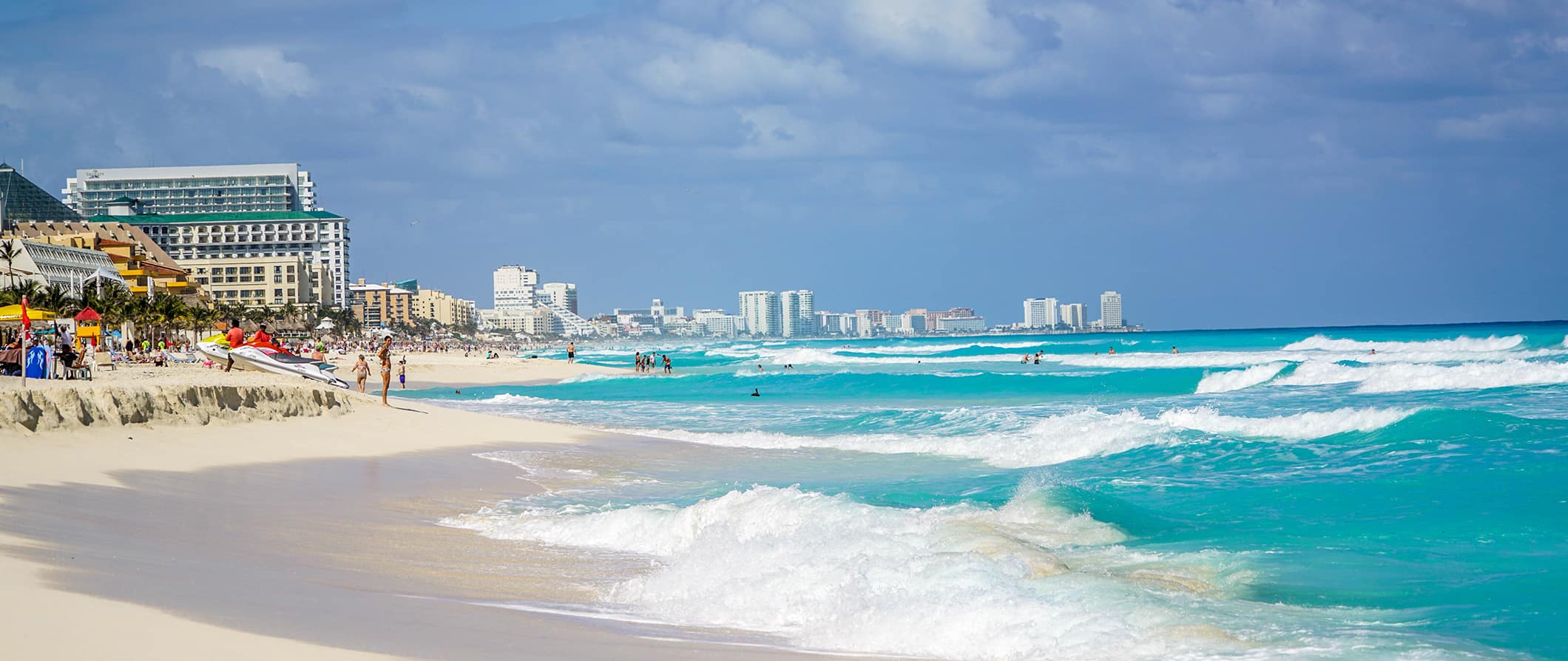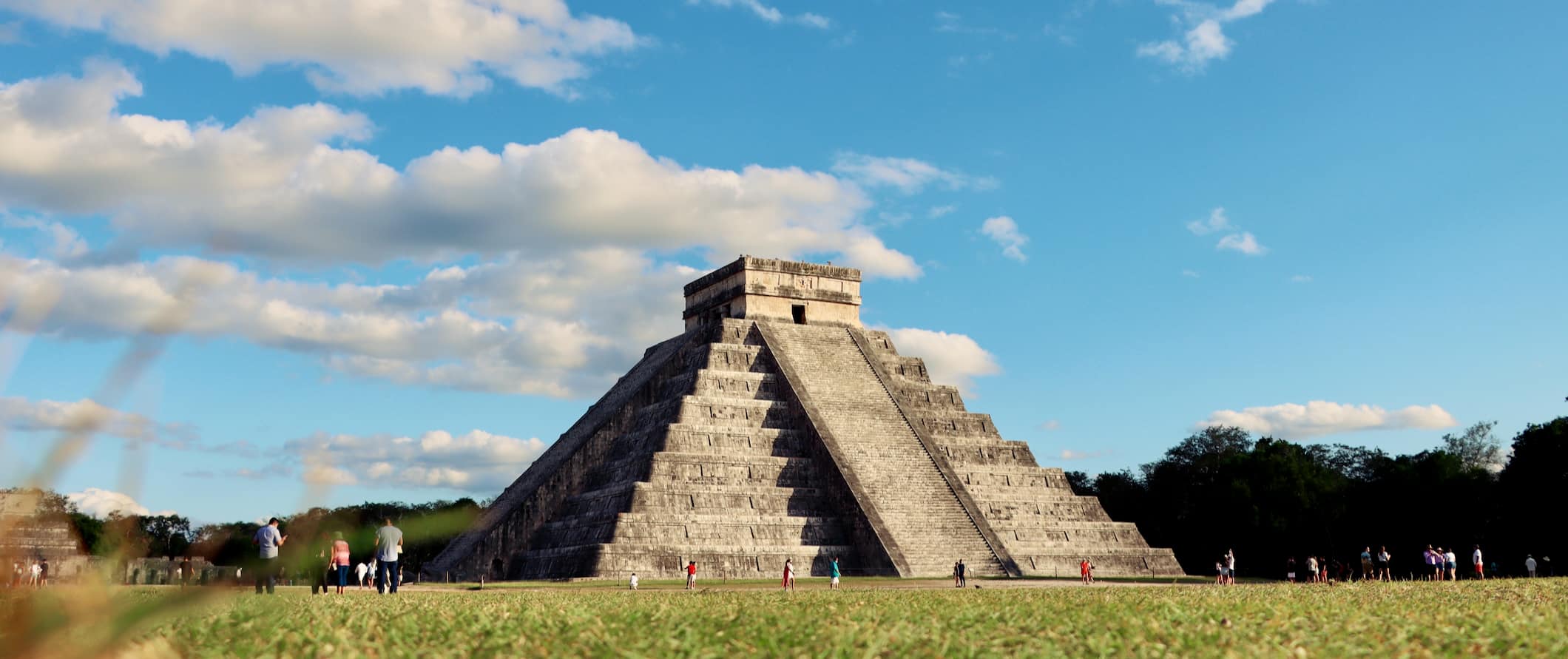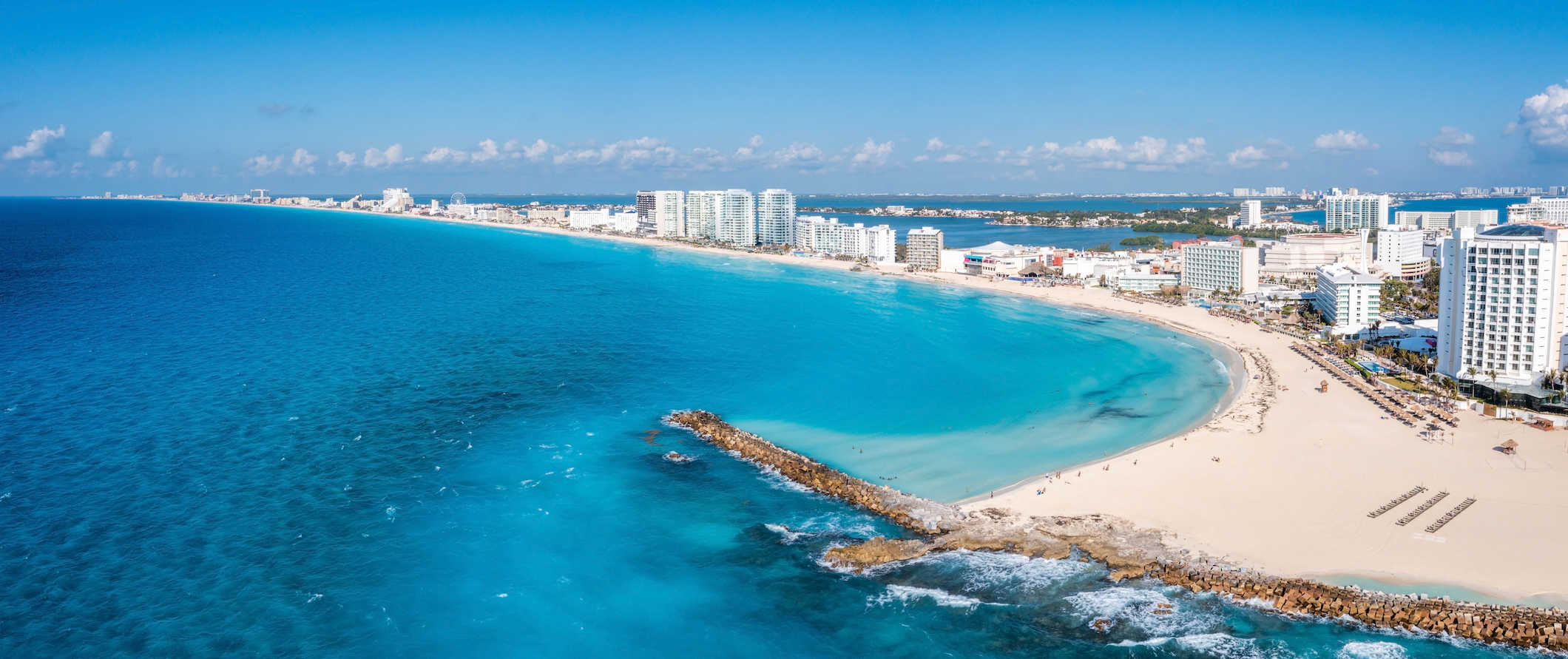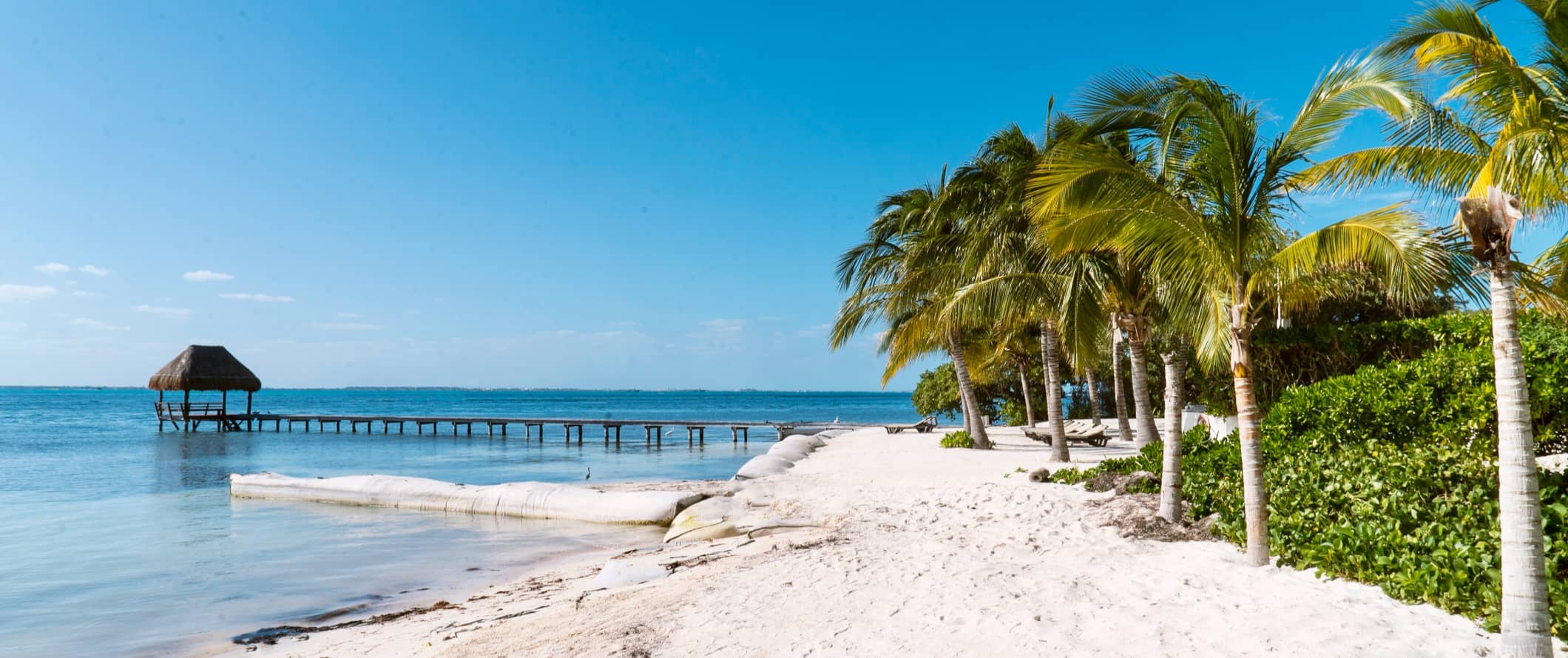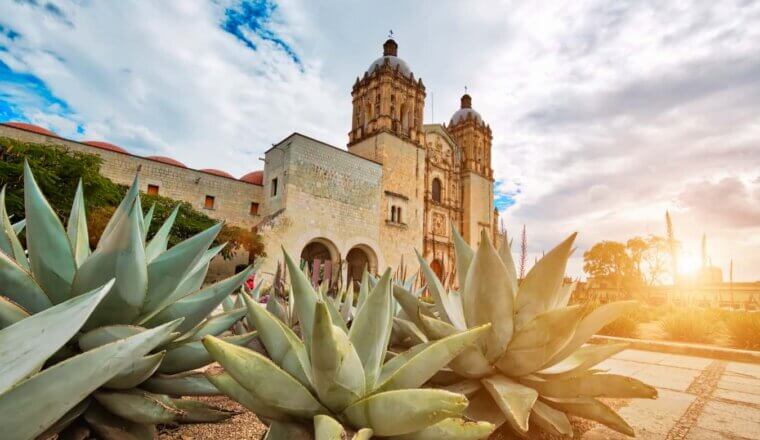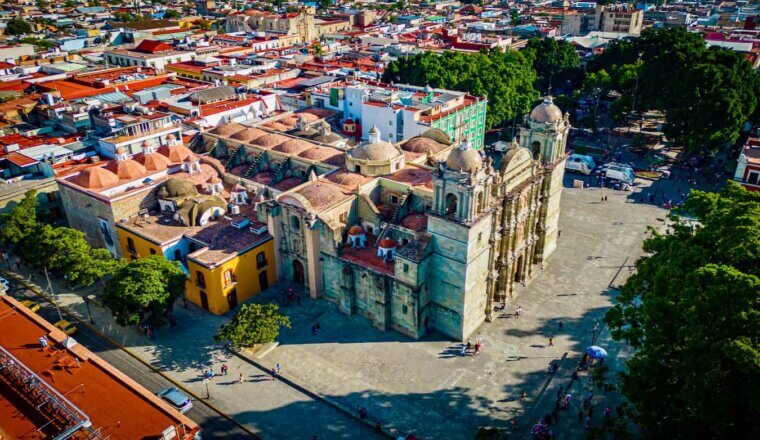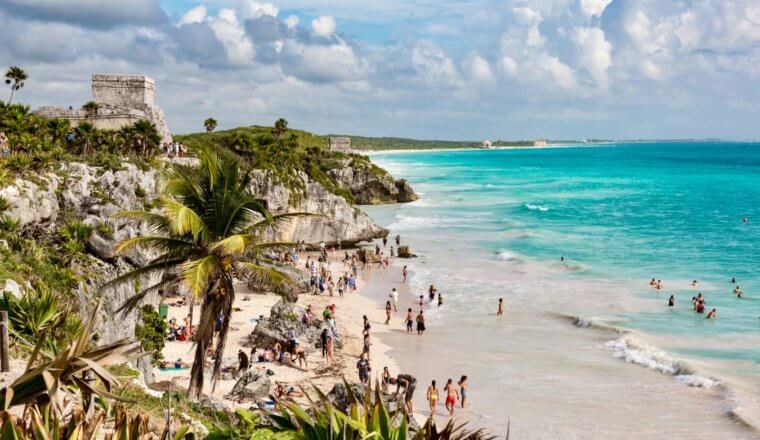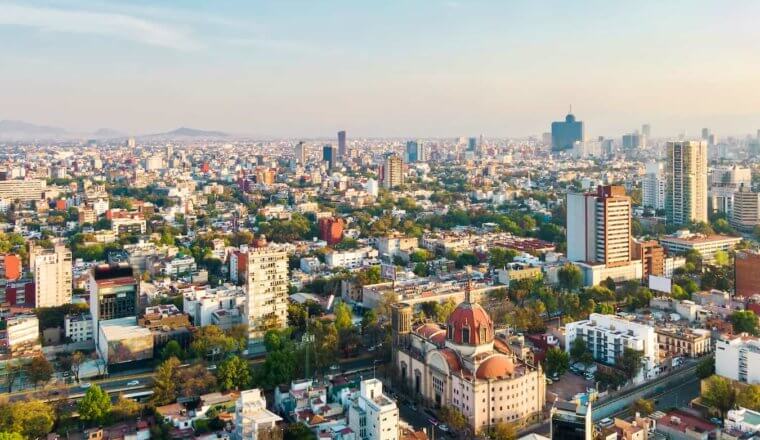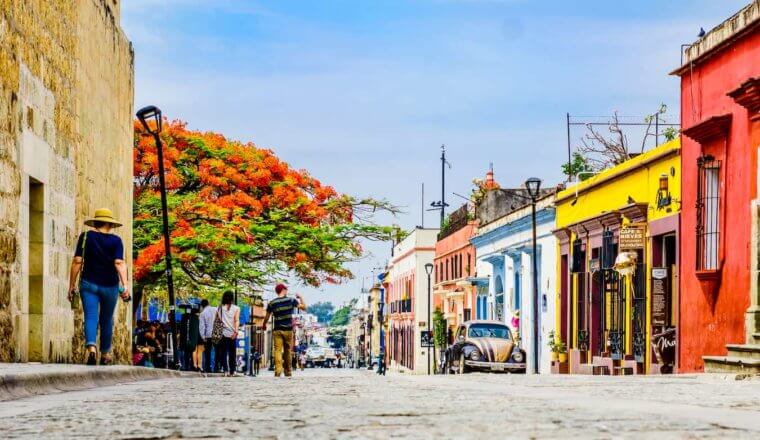Cancun is synonymous with luxury, partying, spring breakers, resorts, and beautiful beaches. It’s often seen as an American playground and the city is a hub for expats and digital nomads in Mexico.
If I’m being honest, the main drag is very touristy and kind of terrible. It’s a good place to go for your stereotypical vacation but there’s not much more than that there. During spring break, college kids flock here to get drunk and tan so it’s best to avoid visiting then (unless you also want to partake in the rowdy festivities). This is a city that was built for tourists.
However, if you leave the main resort area of Cancun, you’ll find a city with friendly people, character, and amazing food. It’s real Mexico!
And, throughout the region, you’ll also find plenty of Mayan ruins and numerous cenotes.
Cancun has a lot more to it than just Senor Frogs, resorts, and drunk college kids, but you do have to go looking for it.
This travel guide to Cancun can help you plan your trip, save money, and make the most of your time in the gorgeous slice of Mexico!
Table of Contents
Top 5 Things to See and Do in Cancun
1. Explore Chichén Itzá
Chichén Itzá is a Mayan ruin dating back to 550 CE. It was home to an estimated 35,000 people – the most populous city in the Yucatan Peninsula. Historians believe the location was chosen due to its proximity to Xtoloc cenote, an underground freshwater source. Today, it is one of the largest (and most popular) Mayan archaeological sites in Mexico and one of the Wonders of the World. You can wander the UNESCO World Heritage Site’s ruins, including 5 square kilometers (1.9 square miles) of temples, intricately carved columns, tombs, and even ball courts. At the center of the ruins sits the famed El Castillo pyramid, a massive structure towering meters (98 feet). Entry is 571 MXN.
2. Explore the cenotes
In Cancun, you can find some of the world’s best underwater cenotes (natural pits or sinkholes that expose fresh groundwater) and cavern systems. The Yucatan Peninsula is famous for its cenotes, and they were an important resource for the ancient Maya. Popular cenotes near Cancun include Cenote Azul (150 MXN), Cenote Ik Kil (150 MXN), Gran Cenote (500 MXN), and Cenote Zahil Ha (200 MXN). Most are less than two hours away from the city by car.
3. Relax on Isla Mujeres
Isla Mujeres, which translates to “Women Island,” is just a short ferry ride away from Cancun. Originally a fishing village, the island maintains its charming atmosphere while being home to some 23,000 people. Kayaking, fishing, sailing, and swimming with sharks are popular activities here. You can enjoy snorkeling or scuba diving in the crystal clear Caribbean sea. The island is also a hatching ground for baby sea turtles.
4. Check out Cancun Underwater Museum
The Museo Subacuático de Arte features over 500 underwater sculptures in Cancun National Marine Park, which are designed to be platforms for coral growth to regenerate the damaged ecosystem. You can experience the magic via snorkeling, scuba diving, and glass-bottom boat tours. Since its founding in 2009, a lot of growth has occurred and every spring, more plants bloom. Snorkeling tours of the Underwater Museum cost around 965 MXN.
5. Visit Tulum
Once a vital Mayan port city, Tulum is located 136 kilometers (85 miles) from Cancun. It is best known for its Mayan ruins, which rest on 12-meter (136-foot) bluffs overlooking the Caribbean Sea. Today, the ruins are a popular tourist attraction, however, the town of Tulum is equally popular with its beautiful beaches, surfing, markets, and cheap eats (though I hated my time there). From Cancun, a bus to Tulum costs around 196 MXN. Admission is 85 MXN.
Other Things to See and Do in Cancun
1. Shop at Market 28
The downtown area is home to most of the colorful local craft markets in Cancun. Leather, silver, pottery, glassware, artwork, handicrafts, and traditional Mexican blankets are all sold here, making it the perfect place to browse, people-watch, and shop for souvenirs. It’s open daily from 9am-8pm.
2. Go clubbing
Cancun is famous for its nightlife. Most of the nightlife is concentrated around the Hotel Zone in an area aptly known as “party central.” Many of the world’s biggest DJs make regular appearances in the many clubs. During spring break, things get even more crowded and more expensive so be sure to book early if you’re visiting then. Coco Bongo, La Vaquita, and Grand Mambo Cafe are among the most popular places to go.
3. Hit the spa
Cancun is one of the top spa destinations in the world. There are tons of options to choose from, all offering varying treatments and package deals. Consider an ancient Mayan healing session or go with a classic massage. Temazcal Cancun offers massages for 900 MXN and is best known for its temazcal experiences. A type of sweat lodge, temazcal rituals date back to ancient Mesoamerica and were used to cleanse and purify after a battle, or to aid with healing the sick, as well as women giving birth. This experience lasts 2-3 hours and includes a temazcalero guide, volcanic stones, a bonfire, medicinal herbs, cleansing, and teas. The cost is 1,170 MXN.
4. Visit Museo Maya de Cancún
This museum is located on the south side of the Centro de Convenciones, Cancun’s convention center. Home to around 400 artifacts from important Mayan sites throughout the Yucatan Peninsula and throughout Mexico, the museum is one of the best sites in Mexico for learning about Mayan culture and history. Admission costs 70 MXN and includes access to the San Miguelito Archaeological Zone (an area of Mayan ruins).
5. Go diving
Cancun lies along the Great Mesoamerican Reef, the largest reef in the western hemisphere. The area has over 100 types of coral and more than 160 types of reef-inhabiting fish. There are also 5 different species of sea turtles here, making it a great place to spot local wildlife. Scuba diving costs around 2,700 MXN per person for a two-tank dive.
6. Swim with whale sharks at Isla Contoy
An easy day trip from Cancun, Isla Contoy is a small island nature reserve with stunning beaches and over 100 species of birds. It is also home to a large concentration of whale sharks. Whale sharks can grow up to 15 meters (almost 50 feet) in length but don’t worry, they are gentle giants! The island itself is small (it’s just 8.5 kilometers/5.3 miles long) and is only inhabited by a handful of biologists. Just 200 people are allowed on the island each day. You can book tours through a tour agency or hotel, or you can apply to visit with the park office in Cancun. Contoy Adventures is a well-known tour agency offering whale shark experiences for 3,260 MXN. Tours operate from May 20th until September 17th.
7. Take a cooking class
Cooking classes are one of the best ways to learn about a new culture (and the skills you learn are a great souvenir too). Mexico Lindo is one of the best in the Cancun area. Located in the jungle, the class duration is roughly 5.5 hours and includes breakfast, cooking a 6-course meal, snacks, and a tequila tasting. Cooking classes are scheduled Monday through Friday, with a different menu each day. The cost is 2,600 MXN.
8. Go on a taco tour
Street tacos are one of the best things about traveling in Mexico. Cancun Food Tours offers a 3.5-4.5-hour tour through downtown Cancun which includes a market tour and plenty of yummy taco tastings, with the opportunity to make your own tortillas, too. They also have vegetarian substitutions available as well. Tours cost 1,479 MXN per person.
For information on other cities in Mexico, check out these guides:
Cancun Travel Costs
Hostel prices – Hostels are extremely affordable and plentiful in Cancun. There are 6-person dorm rooms for as little as 280 MXN, though 450 MXN is a more realistic price. For a private room, prices start at 1,000-1,500 MXN for a room that sleeps two. Most hostels offer free Wi-Fi and free breakfast.
Budget hotel prices There are plenty of budget hotels in Cancun with prices starting around 600 MXN per night for a room that sleeps two. You can find rooms in a 3-star hotel for as low as 950 MXN per night, which includes a private bathroom, Wi-Fi, and usually free breakfast as well.
For Airbnb, private rooms average around 590 MXN per night (though you can find places for as little as 300 MXN per night). However, there are very few private room options available here. Entire homes (including studio apartments) start from 800-1,500 MXN per night. Be sure to book early to find the best deals.
Food – You’ll find a lot of rice, beans, fruits, and veggies like tomatoes, corn, avocado, and peppers in Mexican cuisine. Typical Mexican dishes include tacos, salsa, enchiladas, tamales (stuffed corn pockets), pozole (hominy stew topped with onion, avocado, and chili), and guacamole.
Street stalls and markets are the bestplace to find authentic and inexpensive food. Tacos, quesadilla, sopas, tortas, and other street foods cost generally between 15-45 MXN. Sometimes, you’ll find tacos for as cheap as 10 MXN. In Mexico, street food is the best – and most affordable- option. It’s the tastiest too and you should eat it as much as possible. It’s not gonna make ya sick if you eat where other people are eating.
A beer is around 30 MXN but double that at a restaurant.
Restaurants found in the Hotel Zone or near the beach are good but they are expensive as they cater mostly to the tourists staying in the zone. You can expect to pay 500 MXN or more for a meal in these restaurants.
Closer to downtown, you’ll find a variety of restaurants with dishes between 120-300 MXN. Choose from sushi joints and cafés serving bagels, pizza and pasta, to Indian, Middle Eastern, and French restaurants. Try La Troje, Café Con Gracia, or Café Antoinette.
A meal at a Mexican restaurant serving traditional cuisine costs around 120-400 MXN. Look for the ones filled with locals as that is generally a sign that the food is really good.
Tap water is not safe to drink in Mexico. Bring a portable water purifier or use bottled water (LifeStraw makes a good one.
If you plan to cook your meals, expect to pay between 500-585 MXN per week for groceries. This gets you staples like rice, vegetables, chicken, tortillas, and beans. However, with street food so cheap and most hostels and hotels lacking kitchens, it’s best to simply eat local rather than cook.
Backpacking Cancun Suggested Budgets
If you’re backpacking Cancun, expect to spend 1,000 MXN per day. This budget gets you a hostel dorm, street food and self-cooked meals, public transportation to get around, and mostly free or cheap activities like snorkeling and enjoying the beach. If you’re drinking a lot, I’d add another 100-300 MXN per day depending on how much you want to party.
On a mid-range budget of 1,800 MXN per day, you can stay in a private Airbnb, eat at restaurants serving cheap traditional cuisine, enjoy a few drinks, take the occasional taxi to get around, and do more paid activities like cooking classes or museum visits.
On a “luxury” budget of 3,800 MXN or more per day, you can stay in a hotel, eat out for all your meals anywhere you want, have plenty of drinks, take taxis everywhere or rent a car, and do some guided food or mezcal tours. This is just the ground floor for luxury though. The sky is the limit!
Cancun Travel Guide: Money-Saving Tips
Outside the resort and tourist area, Cancun, like the rest of Mexico, won’t break the bank. Inside that area, everything is priced for tourists and you’ll burn through your money pretty easily. Here are some ways to save in Cancun to help you keep your budget intact:
- Eat street food – The street stalls that line the streets in Mexico are safe to eat at and provide the cheapest and tastiest food around. If you don’t want to eat there, find restaurants that cater to locals. If you start eating that’s designed for tourists, you’ll pay triple what you should.
- Travel off-peak – Try to visit Cancun in the off-season (between June and November) as accommodation is significantly cheaper.
- Stay with a local – Don’t want to book a room at a resort? Use Couchsurfing to stay with locals who have extra beds and couches for free. You’ll not only save money on accommodation but you’ll get to connect with a local who can share their insider tips and advice.
- Save money on rideshares – Uber is cheaper than taxis and is the best way to get around a city if you don’t want to wait for a bus or pay for a taxi.
- Being a water filter – Since the tap water here isn’t safe to drink and single-use plastic is bad for the environment, bring a water filter. LifeStraw makes reusable bottles with a built-in filter so you can ensure your water is always clean and safe.
Where to Stay in Cancun
Cancun has plenty of fun and affordable hostels. Here are my suggested places to stay:
How to Get Around Cancun
Public transportation – Cancun is pretty easy to get around. The bus runs 24 hours and fares cost 8.50 MXN. Try to have exact change as drivers cannot break big bills.
Taxi – In Cancun, taxis are not metered, but 30 MXN is a good guideline for city center travel. I’d skip the taxis if you can though as they add up fast.
Ridesharing – Uber is available here and is cheaper than taxis. A ride from the hotel zone to downtown costs around 198 MXN.
Bicycle – Cancun isn’t ideal for cycling but if you want to get around by bike, rentals cost 220-350 MXN per day.
Car rental – If you want to rent a car to explore the area, expect to pay around 800 MXN per day. An international driver’s license is not required. For the best car rental prices, use Discover Cars.
When to Go to Cancun
Summer (May to October) is the rainy season in Cancun. You can expect it to rain each day heavily, but the downpour is usually short. Temperatures during this time are somewhere between 24-32°C (75-90°F).
From the beginning of August to the end of November is hurricane season and is not a good time to visit.
December to the end of April (winter) is the busiest tourist season and Cancun is packed with travelers from all over North America and Europe. This is the best time to visit if you’re looking to take advantage of Mexico’s tropical environment. The hotel zone is overflowing at times, so think about staying outside the zone if you’re on a budget. The average daily temperature during this time is 28°C (82°F). Prices are also higher during this time, especially in the hotel zone.
Spring break is probably one of the busiest times in Cancun as college and university students flock to the hotels and hostels. It is a crazy party and things can become very crowded very quickly. Prices also spike during this time, especially near the beaches. I would avoid coming here during this time unless you really want to splash out and party.
Note: If you plan to do anything in the ocean, be sure to pack biodegradable sunscreen before you leave for your trip. The guides on your snorkeling/diving excursions sometimes won’t tell you until the last minute that regular sunscreen is not allowed (it’s damaging to the coral and overall water quality).
How to Stay Safe in Cancun
Cancun has long been the playground of tourists from throughout North America and Europe. As with most tourist hotspots, the most common crimes here are pickpocketing and bag snatching. This is especially common in crowded areas and on the beach when you’re not paying attention. Make sure to always keep your valuables secure and out of reach.
Overall, dangerous crimes against tourists are uncommon here (it’s mostly jsut petting crime). The people who do tend to be involved in incidents are usually doing drugs or taking part in sex tourism. Avoid all of that and you’ll greatly reduce your risks here.
During busy times like spring break, petty crime increases. Don’t leave drinks unattended and be vigilant with your valuables. Be careful and aware of your surroundings when withdrawing your cash from an ATM. When possible, use indoor ATMs just to be safe.
If you’re worried about getting ripped off, read this blog post about common travel scams to avoid here.
Solo female travelers should generally feel safe here but you’ll definitely want to keep an eye on your drinks, avoid walking alone late at night outside busy areas and just keep a watchful eye. Despite the glitz, this isn’t one of the safest parts of Mexico. For specific tips, check out one of the many solo female travel blogs on the city.
If an emergency occurs, dial 911. If that doesn’t work (since 911 isn’t available everywhere), dial 066.
Always trust your gut instinct. Avoid isolated areas at night, don’t wander around alone at night, and be aware of your surroundings at all times. And make copies of your personal documents, including your passport and ID.
The most important piece of advice I can offer is to purchase good travel insurance. Travel insurance will protect you against illness, injury, theft, and cancellations. It’s comprehensive protection in case anything goes wrong. I never go on a trip without it as I’ve had to use it many times in the past.
Cancun Travel Guide: The Best Booking Resources
These are my favorite companies to use when I travel. They consistently have the best deals, offer world-class customer service and great value, and overall, are better than their competitors. They are the companies I use the most and are always the starting point in my search for travel deals.
- Skyscanner – Skyscanner is my favorite flight search engine. They search small websites and budget airlines that larger search sites tend to miss. They are hands down the number one place to start.
- Hostelworld – This is the best hostel accommodation site out there with the largest inventory, best search interface, and widest availability.
- Booking.com – The best all around booking site that constantly provides the cheapest and lowest rates. They have the widest selection of budget accommodation. In all my tests, they’ve always had the cheapest rates out of all the booking websites.
- Get Your Guide – Get Your Guide is a huge online marketplace for tours and excursions. They have tons of tour options available in cities all around the world, including everything from cooking classes, walking tours, street art lessons, and more!
- SafetyWing – Safety Wing offers convenient and affordable plans tailored to digital nomads and long-term travelers. They have cheap monthly plans, great customer service, and an easy-to-use claims process that makes it perfect for those on the road.
- LifeStraw – My go-to company for reusable water bottles with built-in filters so you can ensure your drinking water is always clean and safe.
- Unbound Merino – They make lightweight, durable, easy-to-clean travel clothing.
- Top Travel Credit Cards – Points are the best way to cut down travel expenses. Here’s my favorite point earning credit cards so you can get free travel!
Cancun Travel Guide: Related Articles
Want more info? Check out all the articles I’ve written on backpacking/traveling to Cancun and continue planning your trip:
